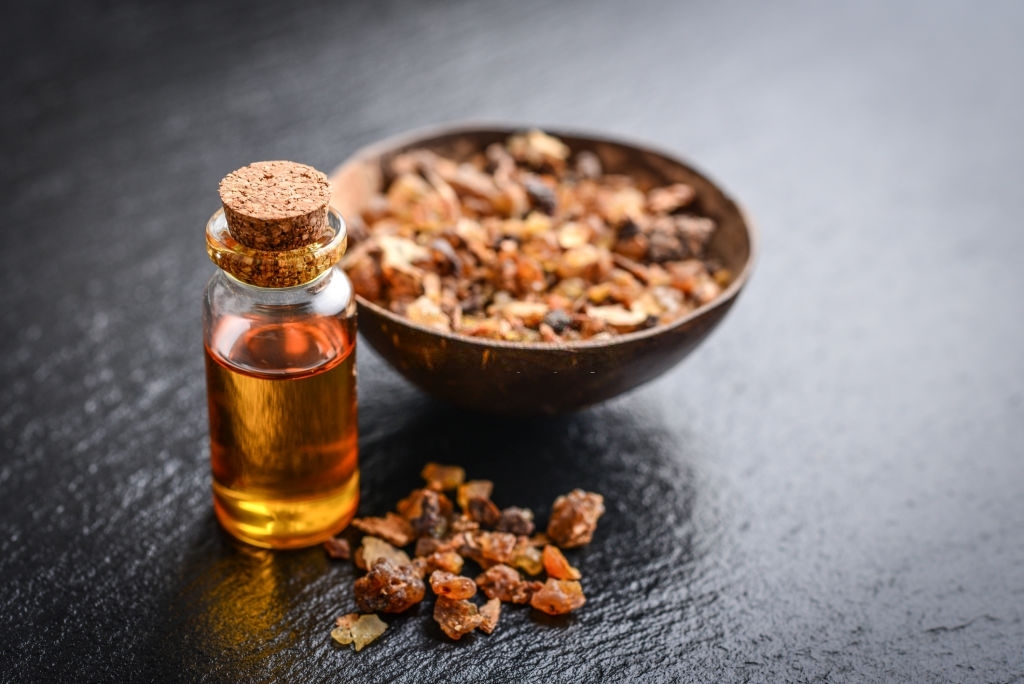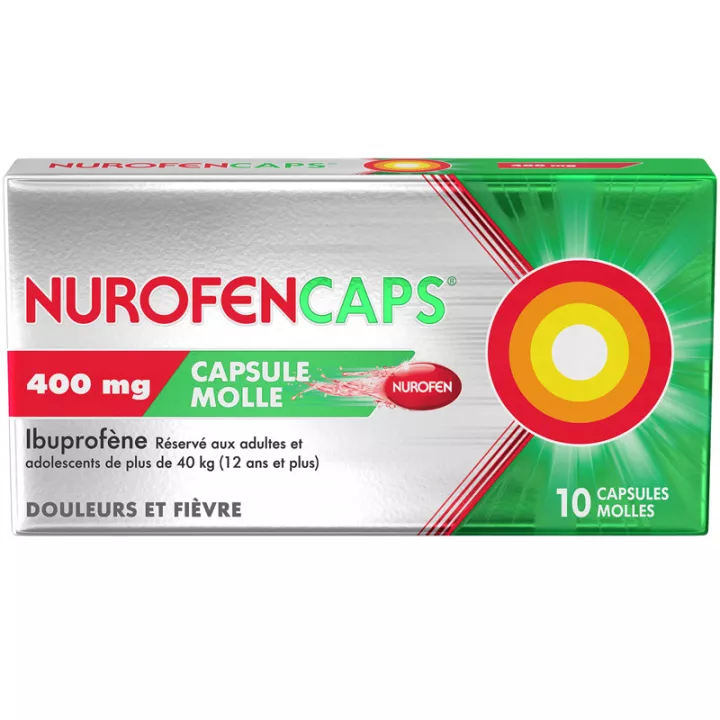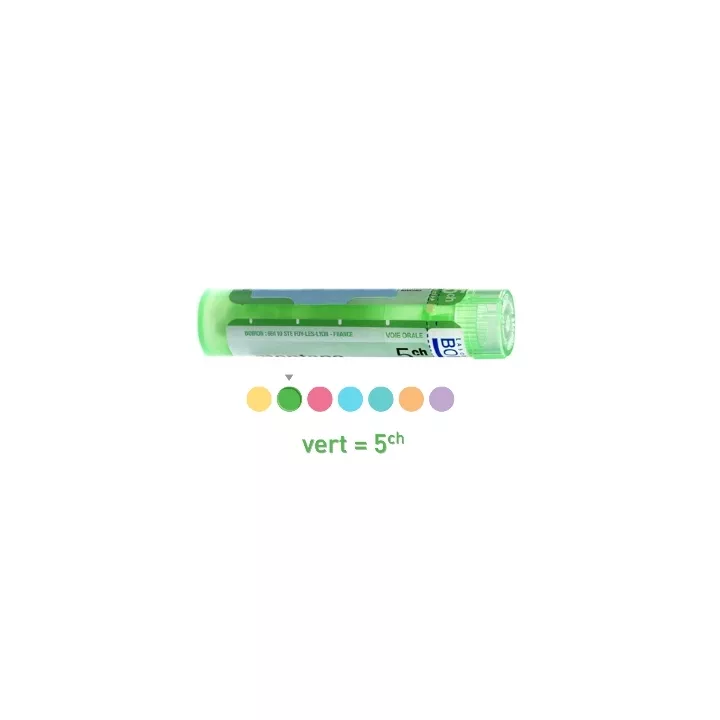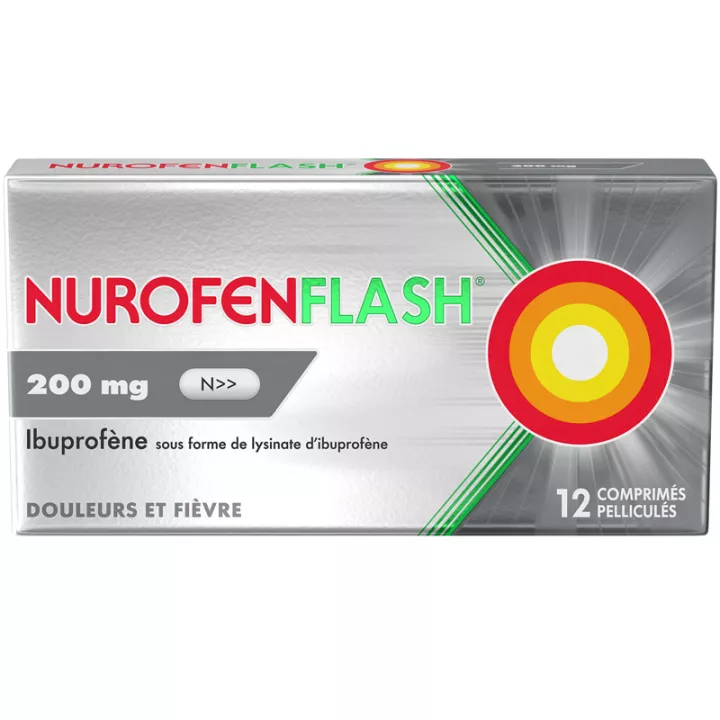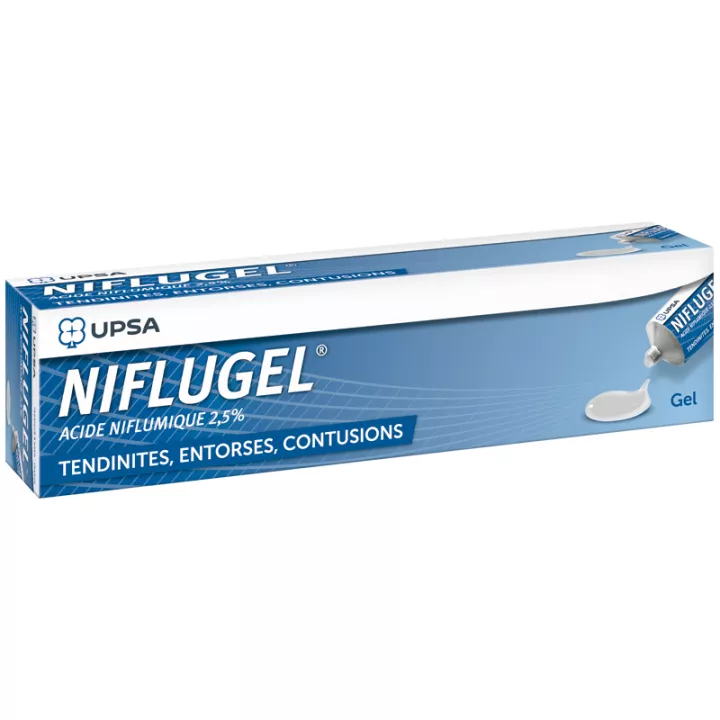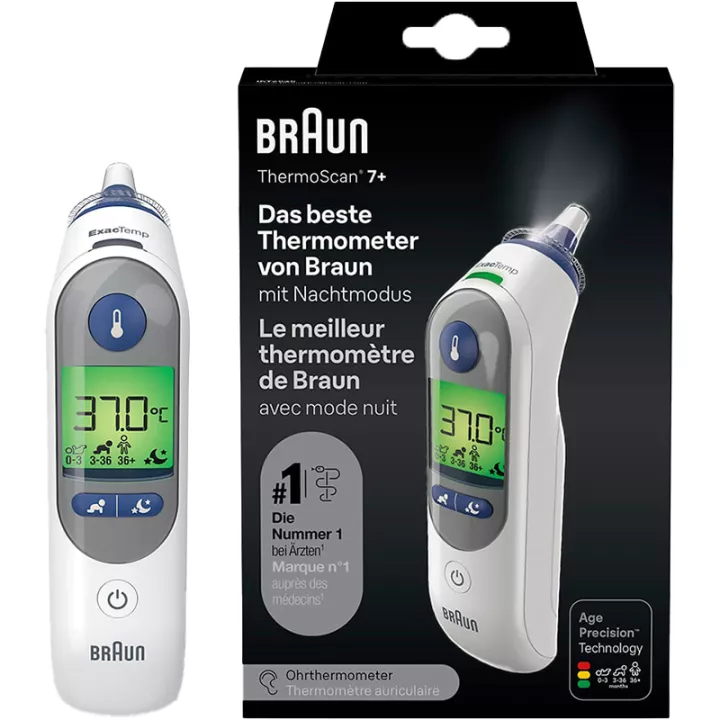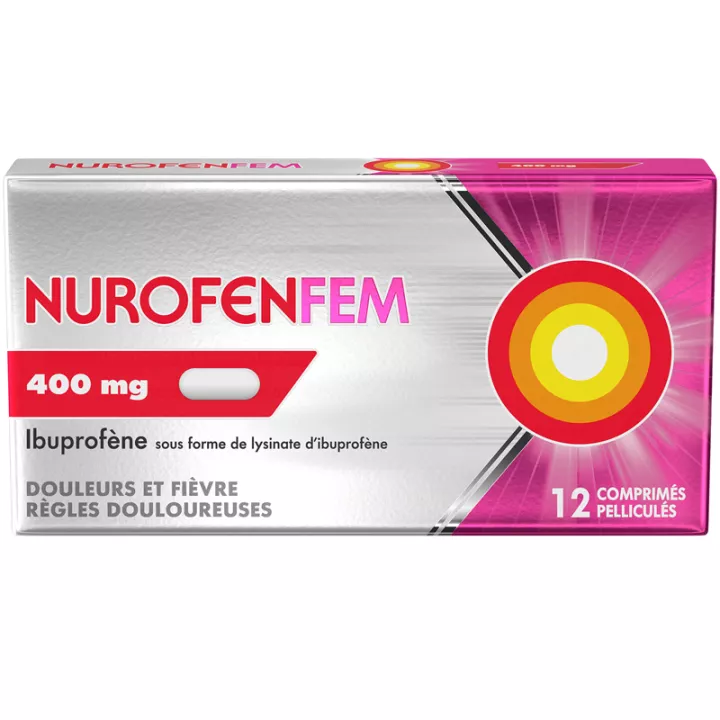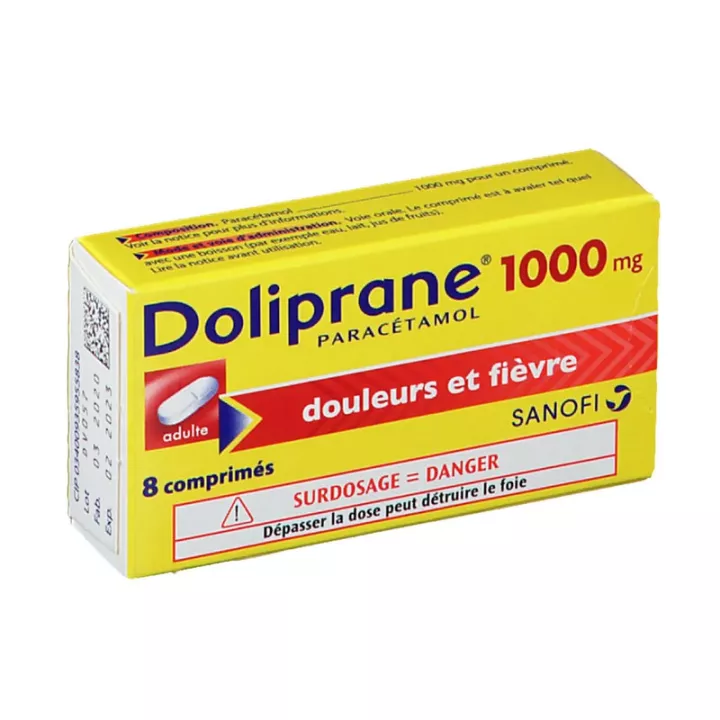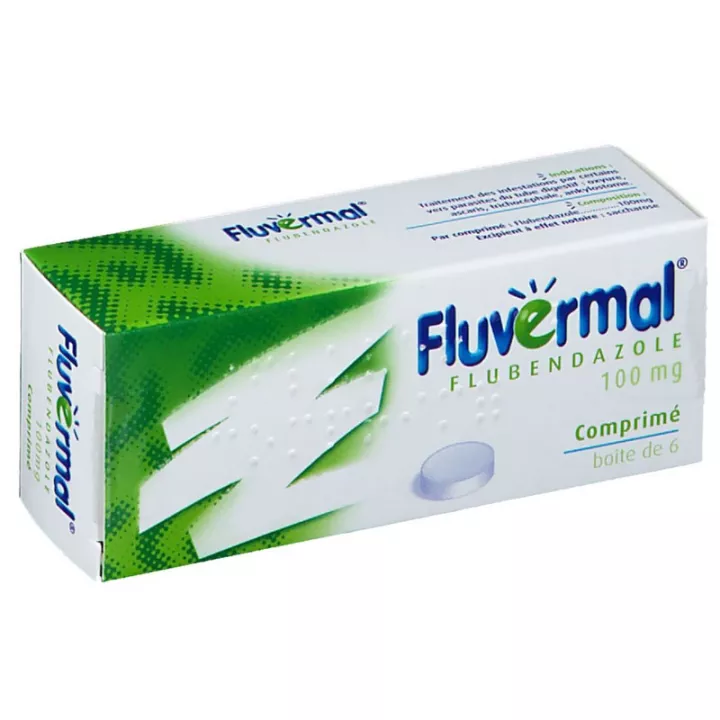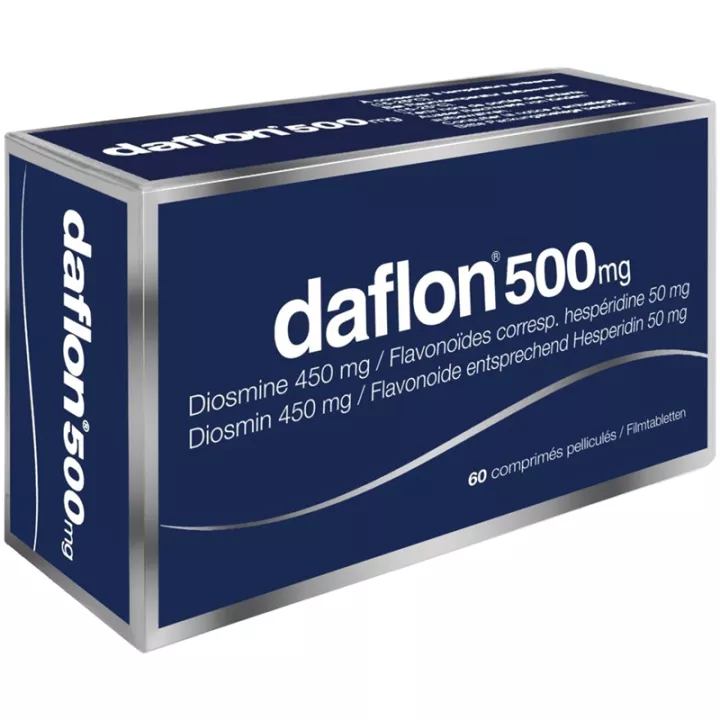NOTICE
ANSM - Last updated: 22/06/2017
Name of the medicinal product
NUROFENFLASH 400 mg film-coated tablet
Ibuprofen
framed
Please read this leaflet carefully before you start taking this medicine because it contains important information for you.
You should always take this medicine by following the instructions in this leaflet or by your doctor or pharmacist.
· Keep this leaflet. You might need to read it again.
· Ask your pharmacist for advice or information.
· If you experience any side effects, talk to your doctor, or your pharmacist. This also applies to any side effects not mentioned in this leaflet. See section 4.
· You should contact your doctor if you experience no improvement or feel less well after:
o 3 days for children and adolescents
o 3 days in case of fever or in case of migraine and beyond 5 days in case of pain in the adult.
What is in this leaflet?
1. What is NUROFENFLASH 400 mg film-coated tablet and in which cases is it used?
2. What information should I take before taking NUROFENFLASH 400 mg film-coated tablets ?
3. How to take NUROFENFLASH 400 mg film-coated tablets ?
4. What are the possible side effects?
5. How to store NUROFENFLASH 400 mg film-coated tablets ?
6. Package contents and other information.
1. WHAT NUROFENFLASH 400 MG, FILM TABLETS AND IN WHAT CASES IS IT USED?
Pharmacotherapeutic group OTHER ANALGESICS AND ANTIPYRETICS - ATC code: M0AE01 / N02B
This medicine contains a non-steroidal anti-inflammatory drug: ibuprofen.
In adults and children over 30 kg (approximately 11-12 years of age), it is indicated in the short-term treatment of fever and / or pain such as headache, flu-like conditions, pain dents, aches and painful periods.
It is indicated in the adult, after at least a medical opinion, in the treatment of migraine attack mild or moderate, with or without aura.
2. BEFORE YOU TAKE NUROFENFLASH 400 MG, FILM TABLET.
Do not take NUROFENFLASH 400 mg film-coated tablets in the following cases:
· after 5 months of pregnancy (24 weeks of amenorrhea),
· a history of allergy or asthma triggered by the use of this drug or a related drug, including other non-steroidal anti-inflammatory drugs, acetylsalicylic acid (aspirin),
· antecedent allergy to the other constituents of the tablet,
· history of gastrointestinal bleeding or ulcers associated with previous NSAID treatments,
· ulceration or bleeding of the stomach or intestine in progress or recurrence,
· gastrointestinal haemorrhage, cerebral hemorrhage or other ongoing hemorrhage,
· severe liver disease,
· severe kidney disease,
· serious heart disease,
· systemic lupus erythematosus,
IN CASE OF DOUBT, IT IS ESSENTIAL TO ASK FOR THE OPINION OF YOUR DOCTOR OR YOUR PHARMACIST.
Warnings and Precautions
Talk to your doctor or pharmacist before taking NUROFENFLASH 400 MG, film-coated tablets .
In high doses, greater than 1200 mg / day, this drug has anti-inflammatory properties and can cause serious disadvantages that are observed with non-steroidal anti-inflammatory drugs.
Anti-inflammatory / analgesic drugs such as ibuprofen are likely to be associated with a slightly increased risk of heart attack or stroke, especially when used at high doses. Do not exceed recommended dosage or treatment time.
Discuss your treatment with your doctor or pharmacist before taking NUROFENFLASH 400 mg film-coated tablets if you:
· have heart problems, heart failure, angina (chest pain) or have had a heart attack, surgical bypass, peripheral arterial disease (poor circulation in the legs or feet due to narrowed arteries or blocked) or any type of stroke (including "mini-strokes" or transient ischemic attacks (TIAs)).
· have high blood pressure, diabetes, high cholesterol, a family history of heart disease or stroke, or if you are a smoker.
The diagnosis and follow-up of the migraine crisis in children requires medical advice.
Special warnings
If you are a woman, NUROFENFLASH 400 mg film-coated tablet can alter your fertility. Its use is not recommended in women who wish to conceive a child. For women who have reproductive difficulties or who are undergoing reproductive function tests, talk to your doctor or pharmacist before taking NUROFENFLASH 400 mg film-coated tablets.
Elderly patients have a higher risk of adverse effects, particularly for gastrointestinal haemorrhage, ulcers and perforations. Renal, hepatic and cardiac functions should be closely monitored. The dosage should be as low as possible for the shortest time needed to relieve symptoms.
There is a risk of kidney failure in dehydrated adolescents.
BEFORE YOU USE THIS MEDICINE, CONSULT YOUR DOCTOR IN CASE:
· a history of asthma associated with chronic rhinitis, chronic sinusitis or polyps in the nose. Administration of this specialty may lead to an asthma attack, especially in patients who are allergic to acetylsalicylic acid (aspirin) or to a non-steroidal anti-inflammatory drug ( see section "Never take NUROFENFLASH 400 mg film-coated tablets following cases " ),
· coagulation disorders, and anticoagulant therapy. This medication may cause severe gastrointestinal symptoms,
· digestive antecedents (hiatal hernia, digestive hemorrhage, old stomach or duodenal ulcer),
· heart disease, liver or kidney disease,
· of varicella. This medication is not recommended because of exceptional severe infections of the skin,
· concomitant treatment with other drugs that increase the risk of peptic ulcer or haemorrhage, eg, oral corticosteroids, antidepressants (SSRIs, ie, Selective Serotonin Recapture Inhibitors), medicines preventing the formation of blood clots such as aspirin or anticoagulants such as warfarin. If you are in any of these conditions, talk to your doctor before taking NUROFENFLASH 400 mg film-coated tablets ( see section "Other medicines and NUROFENFLASH 400mg film-coated tablet )".
· concomitant therapy with methotrexate at doses greater than 20 mg per week or with pemetrexed ( see section " Other drugs and NUROFENFLASH 400mg, film-coated tablet " ).
DURING TREATMENT, IN CASE OF:
· of vision problems, PREVENT YOUR DOCTOR,
· gastrointestinal haemorrhage (discharge from the mouth or stool, stool coloration in black), STOP TREATMENT AND IMMEDIATELY CONTACT AN EMERGENCY MEDICAL OR MEDICAL SERVICE,
· of appearances of cutaneous or mucosal signs that resemble a burn (redness with bubbles or blisters, ulcerations), STOP THE TREATMENT AND CONTACT IMMEDIATELY A DOCTOR OR AN EMERGENCY MEDICAL SERVICE,
· of allergy-related signs including asthma attack or sudden swelling of the face and neck ( see section "What are the possible side effects?" ), STOP TREATMENT AND CONTACT IMMEDIATELY A DOCTOR OR A MEDICAL SERVICE EMERGENCY.
This medicine contains a non-steroidal anti-inflammatory drug: ibuprofen . You should not take other medicines containing non-steroidal anti-inflammatory drugs (including selective cyclooxygenase 2 inhibitors) and / or acetylsalicylic acid (aspirin) at the same time as this medication. Read carefully the instructions for other medicines you are taking to ensure that there are no nonsteroidal anti-inflammatory drugs and / or acetylsalicylic acid (aspirin). |
Other medicines and NUROFENFLASH 400 mg film-coated tablet
Inform your doctor or pharmacist if you are taking, have recently taken or may take any other medicines.
CERTAIN MEDICINAL PRODUCTS MAY NOT BE USED AT THE SAME TIME, WHILE OTHER MEDICINES REQUIRE SPECIFIC CHANGES (DOSE, FOR EXAMPLE).
Always inform your doctor, dentist or pharmacist if you are taking any of the following medicines in addition to NUROFENFLASH 400 mg film-coated tablet:
· aspirin (acetylsalicylic acid) or other non-steroidal anti-inflammatory drugs
· corticosteroids
· oral anticoagulants such as warfarin, injectable heparin, antiplatelet agents or other thrombolytics such as ticlopidine
· lithium
· methotrexate
· angiotensin converting enzyme inhibitors, diuretics, beta-blockers and angiotensin II antagonists
· some antidepressants (selective serotonin reuptake inhibitors)
· pemetrexed
· ciclosporin, tacrolimus.
NUROFENFLASH 400 mg film-coated tablet is likely to affect or be affected by certain other medications. For example :
· anti-coagulant drugs (ie, which fluidize the blood / prevent the appearance of clots such as aspirin / acetylsalicylic acid, warfarin, ticlopidine)
· medicines that reduce high blood pressure (ACE inhibitors such as captopril, beta-blockers such as atenolol, angiotensin-II receptor antagonists such as losartan)
Some other medicines are also likely to affect or be affected by treatment with NUROFENFLASH 400 mg film-coated tablets. Therefore, you should always consult your doctor or pharmacist before using NUROFENFLASH 400 mg film-coated tablet along with other medicines.
NUROFENFLASH 400 mg film-coated tablets with food and beverages
Not applicable.
Pregnancy, breast-feeding and fertility
If you are pregnant or breastfeeding, think you may be pregnant or plan a pregnancy, ask your doctor for advice or pharmacist before taking this medication.
Pregnancy
During the first trimester of pregnancy (12 weeks of gestation is 12 weeks 1 day of your last menstrual period), your doctor may prescribe this medication if necessary.
2.5 to 5 months of pregnancy (12-24 weeks of amenorrhea), this medication will only be used on the advice of your doctor and in brief dosage. Prolonged use of this medication is strongly discouraged.
After 5 months of pregnancy (in excess of 24 weeks of amenorrhea), you should NOT take this medication because its effects on your child can have serious consequences especially on a cardiopulmonary and renal plan, even with a single dose .
If you are taking this medication when you are more than five months pregnant, please speak to your obstetrician gynecologist for appropriate monitoring.
feeding
This drug passes into breast milk. As a precaution, it should be avoided during breastfeeding.
Driving and using machines
In rare cases, taking this medicine may cause dizziness and blurred vision.
3. HOW TO TAKE NUROFENFLASH 400 MG, FILM TABLET?
Always take this medication exactly as prescribed by your doctor or pharmacist. Check with your doctor or pharmacist if in doubt.
The occurrence of adverse reactions can be minimized by using the lowest possible dose for the shortest duration necessary to alleviate the symptoms.
Method and route of administration
Oral use. Short-term use.
Swallow the tablet without chewing it, with a large glass of water.
The tablets should be taken preferably during a meal.
Dosage
Painful and / or febrile conditions
RESERVED FOR ADULTS AND CHILDREN FROM 30 kg (about 11-12 years).
The usual dosage is 1 tablet (400 mg) per dose, to be renewed if necessary after 6 hours. In all cases, do not exceed 3 tablets per day (ie 1200 mg per day).
The tablet dosed at 400 mg is reserved for pain or fever more intense or not relieved by a tablet dosed with 200 mg of ibuprofen.
Regular intakes help prevent fever or pain. They should be spaced at least 6 hours.
The elderly with an increased risk of adverse effects should use the lowest possible dose for the shortest time necessary to relieve symptoms.
Do not exceed the recommended doses or the duration of treatment (3 days in case of fever or migraine, 5 days in case of pain).
The maximum dose is 3 tablets per day (1200 mg).
In the event of a migraine attack
RESERVED FOR ADULTS
1 tablet at 400 mg as soon as possible from the onset of the crisis.
If a patient is not relieved after the first dose, a second dose should not be taken during the same course. However the crisis can be treated with another treatment that is not a nonsteroidal anti-inflammatory or aspirin.
If the pain reappears a second dose can be taken as long as it meets an 8 hour interval between the 2 doses.
If in doubt, ask your doctor or pharmacist for advice.
Duration of treatment
In children and adolescents:
If treatment should be continued for more than 3 days or if symptoms worsen, consult a physician.
In adults:
If the pain persists for more than 5 days or if fever or migraine persists for more than 3 days, or if it worsens or if another disorder occurs, inform your doctor. In case of a migraine attack the duration of treatment should not exceed 3 days.
If you feel that the effect of NUROFENFLASH 400 mg film-coated tablets is too strong or too weak, talk to your doctor or pharmacist.
Always take this medication exactly as prescribed in this leaflet or as directed by your doctor or pharmacist. Check with your doctor or pharmacist if in doubt.
If you take more NUROFENFLASH 400 mg film-coated tablets than you should
Immediately consult your doctor or pharmacist.
If you forget to take NUROFENFLASH 400 mg film-coated tablet
Do not take a double dose to make up for the single dose that you have forgotten to take.
If you stop taking NUROFENFLASH 400 mg film-coated tablet
Not applicable.
If you have any further questions on the use of this medication, ask your doctor or pharmacist.
4. WHAT ARE POSSIBLE SIDE EFFECTS?
Like all medicines, this medicine may cause side effects, although not everybody gets them.
Medications such as NUROFENFLASH 400 mg film-coated tablet may increase the risk of heart attack (myocardial infarction) or stroke.
· May cause allergic reactions:
o rash: rash on the skin, itching, edema, aggravation of chronic urticaria,
o respiratory disorders: asthma attack,
o general: sudden swelling of the face and neck (angioedema).
In rare cases, gastrointestinal hemorrhage may occur ( see Warnings and Precautions ). This is all the more frequent when the dosage used is high.
Exceptionally, there may be headaches accompanied by nausea, vomiting and neck stiffness.
Very rarely, bullous manifestations of the skin or mucous membranes (burning sensation accompanied by redness with bubbles, blisters, ulcerations) may occur.
Exceptionally, severe skin infections have been observed in cases of chicken pox.
In all these cases, immediately stop treatment and notify your doctor.
During treatment, there may be:
· digestive disorders: stomach upset, vomiting, nausea, diarrhea, constipation,
· dizziness or headache, rare visual disturbances, significant decrease in urine, renal insufficiency.
In all these cases, tell your doctor.
Exceptionally, there have been changes in liver function or blood counts (decreased white blood cells or red blood cells) that may be severe.
If you notice any side effects not listed in this leaflet, please tell your doctor or pharmacist.
Declaration of side effects
If you experience any side effects, talk to your doctor or pharmacist. This also applies to any side effects not mentioned in this leaflet. You can also report adverse reactions directly via the national reporting system: National Agency for the Safety of Medicines and Health Products (ANSM) and network of Regional Centers of Pharmacovigilance - Website: www.ansm.sante.fr
By reporting adverse reactions, you are helping to provide more information about the safety of the drug.
5. HOW TO STORE NUROFENFLASH 400 MG, FILM TABLET?
Keep this medicine out of the reach and sight of children.
Expiration date
Do not use this medicine after the expiry date which is stated on the carton.
The expiry date refers to the last day of the month.
Storage conditions
Store at a temperature not exceeding 25 ° C.
If necessary, warnings against visible signs of deterioration
Do not throw any medicines into drains or rubbish. Ask your pharmacist to remove any medications you are no longer using. These measures will help protect the environment.
6. PACKAGE CONTENTS AND OTHER INFORMATION
What NUROFENFLASH 400 MG contains, FILM TABLET
· The active substance is:
Ibuprofen ................................................. .................................................. 400.00 mg
In the form of ibuprofen lysinate ........................................... ........................................... 684.00 mg
For a film-coated tablet.
· The other components are:
Core: povidone, sodium carboxymethyl starch (type A), magnesium stearate.
Coating: hypromellose, talc, OPASPRAY white M-1-7111 B (hypromellose, titanium dioxide (E171)).
Black printing ink: shellac, black iron oxide (E172), propylene glycol (E1520)
What is NUROFENFLASH 400 mg film-coated tablets and contents of the pack
This drug is in the form of film-coated tablet.
Box of 10, 12 or 15.
Not all pack sizes may be marketed.
Marketing Authorization Holder
RECKITT BENCKISER HEALTHCARE FRANCE
38 RUE VICTOR BASCH
CS 11018
91305 MASSY CEDEX
Marketing Authorization Operator
RECKITT BENCKISER HEALTHCARE FRANCE
38 RUE VICTOR BASCH
CS 11018
91305 MASSY CEDEX
Maker
RECKITT BENCKISER HEALTHCARE INTERNATIONAL LIMITED
NOTTINGHAM SITE
THANE ROAD, NOTTINGHAM
NOTTINGHAMSHIRE, NG 90 2 DB
UK
Names of the medicinal product in the Member States of the European Economic Area
Not applicable.
The last date on which this leaflet was revised is:
[to be completed later by the holder]
<{MM / YYYY}> <{YYYY month}.>
Other
Detailed information on this medicine is available on the ANSM website (France).
Health education councils:
"WHAT TO DO IN THE EVENT OF FEVER":
The normal temperature of the body is variable from one individual to another and between 36.5 ° C and 37.5 ° C. An increase of more than 0.8 ° C is considered a fever.
In adults and children over 30 kg (11-12 years): if it is too troublesome, you can take a medicine that contains ibuprofen at the indicated dosage.
With this medication, the fever should drop rapidly. However :
· if other signs appear (such as a rash),
· if the fever persists for more than 3 days or if it worsens,
· if the headache becomes violent, or in case of vomiting,
CONSULT YOUR DOCTOR IMMEDIATELY.
"WHAT TO DO IN CASE OF PAIN":
In the absence of improvement after 5 days of treatment,
· If the pain returns regularly,
· If accompanied by fever,
· If she wakes you up at night,
CONSULT YOUR DOCTOR IMMEDIATELY.
"WHAT TO DO IN CASE OF MIGRAINE":
What is migraine?
Migraine is a disease that results in severe headaches, occurring in seizures, for 4 to 72 hours and can be repeated several times a month. It can sometimes be preceded by visual and / or sensory signs called aura (impression of luminosity or flicker of the visual field, illusion that a fly seems to cross the visual field ...).
Migraine or headache?
Misuse of language is often referred to as migraine instead of a simple headache (headache). The following questions can help you identify if you are migraineous. You can fill it alone or with the help of your pharmacist.
1. Your headache evolves in crises of a few hours to 3 days (without treatment).
Between crises, you do not suffer from the head. Yes □ No □
2. You have presented at least 5 crises in your life. Yes □ No □
3. Your headache has at least 2 of the following characteristics: Yes □ No □
· located at one side of the head,
· pulsatile,
· increased by effort (climbing a staircase, running, coughing),
· the painful intensity of the crisis goes from strong to very strong.
4. Your headache is accompanied by at least 1 of the following signs: Yes □ No □
· want to vomit or vomit,
· discomfort to light (photophobia) and / or noise (phonophobia).
If you answered YES:
· to the 4 questions: you are surely migraineous
· to 3 questions: you are probably migraineous
· to 1 or 2 questions: you are probably not migraineous
Discuss these results with your doctor so that he / she can confirm the diagnosis and agree with you the most appropriate treatment.
How to deal with crises?
Some elements such as fatigue, stress, food (chocolates, alcohol ...), sensory factors (noise, flashing light, perfumes, etc.) or physiological factors such as menstruation are likely to trigger migraine attacks.
Knowledge of the triggering factors as well as the warning signs that can precede the crisis makes it possible to start a treatment early (ideally within an hour after its start and while it is still of mild intensity). The earlier the treatment, the more effective and often short-lived (early treatment limits migraine recurrence).
Note on a diary or notebook the timing and duration of your seizures, the intensity of the pain, the possible triggers and the medications used for each attack will help your doctor assess your migraine and its treatment.
A failure on a first crisis does not necessarily mean failure on subsequent crises. The efficacy of 400mg ibuprofen should be evaluated on 2 or 3 seizures. To help you, you can answer the following questions and discuss them with your doctor and pharmacist.
Are you relieved 2 hours after taking? Yes □ No □
Do you have side effects (digestive or other)? Yes □ No □
Do you use a single medication intake? Yes □ No □
Can you resume your usual activities 2 hours after taking? Yes □ No □
When to see your doctor? (this part should perhaps be well separated)
If most headaches are of benign origin, it should not be ignored that they may be the symptom of sometimes severe conditions requiring specialized treatments.
You should consult your doctor in the following cases:
· Early headache crisis.
· Beginning of headache after 50 years
· Triggers headaches through physical exertion, sexual intercourse, coughing.
· Installation of a "headache" headache: sudden onset of a headache from one second to the next.
· Appearance of unusual signs accompanying the headache such as:
o Disorders of balance
o Neck stiffness makes neck movements difficult or impossible
o Double vision, blurred vision
o Difficulty speaking,
o Decreased muscle strength, numbness of the arms and legs
o Body temperature> 38 ° C
o Aggravation of headaches.
o Headache that does not have its usual character
o Continuous headache
